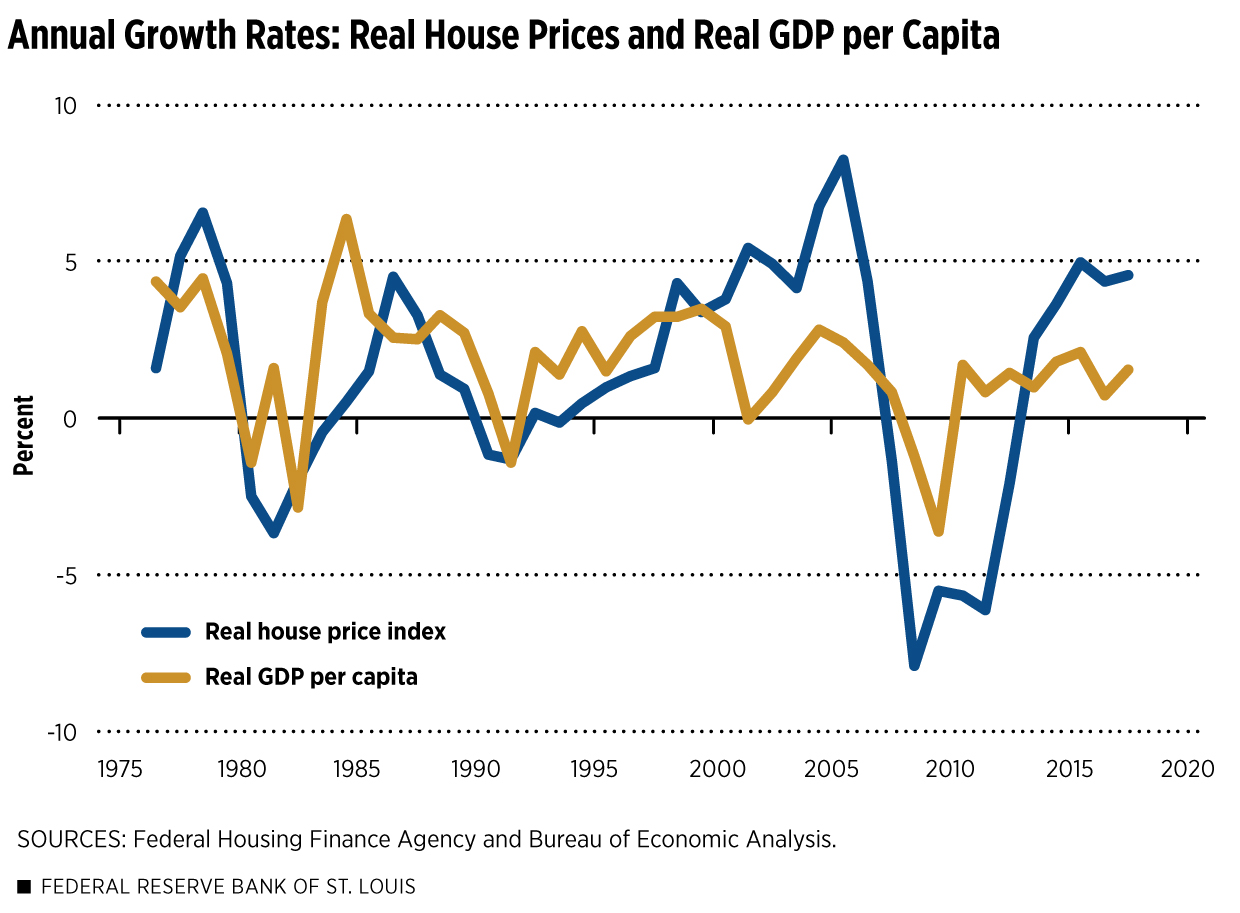Fewer Tax Breaks for Homeowners: A Good Thing?
Broad indexes of real, or inflation-adjusted, house prices generally rise and fall with economic activity. This suggests that what’s good for homeowners, vis-à-vis rising house prices, is also good for the economy. (See the accompanying figure.)
But could a decline in real house prices also be good for the economy? If it’s the result of efficiency-enhancing changes in the tax code, many economists say yes.
Recent Tax Law Changes
The Tax Cuts and Jobs Act (TCJA) of 2017 places new limits on deductions for state and local taxes and property taxes, and scales back the mortgage interest deduction (MID). Many economists expect these changes to reduce the number of taxpayers who claim the MID on itemized returns starting with the 2018 tax year.
Several provisions of TCJA will affect taxpayers:
- The standard deduction was doubled, to $12,000 for individuals and $24,000 for joint filers, making it likely that most low- and middle-income taxpayers who itemized in the past will choose the standard deduction instead.
- State and local taxes are no longer fully deductible, making it less likely that a household’s itemized deductions will exceed the new standard deduction.
- The maximum amount of mortgage debt for which interest can be deducted was reduced to $750,000 from $1 million for joint filers. (Any loans taken out after Dec. 15, 2017 are subject to the new rule; existing mortgages have been grandfathered in with the old limit.)
- The tax deductibility of mortgage interest on second mortgages (i.e., home equity loans) and second homes was scaled back.
- Marginal tax rates were reduced, cutting the value to an itemizer of the MID and all other deductions.
Likely Effects on Housing
As a result of these changes, many economists expect house prices to trend somewhat lower.1 Mortgage borrowing and other aspects of housing, such as the decision to rent or buy, also could be viewed differently.
While some homeowners may lose wealth in the short run, the benefits many economists see from a reduction in the MID and lower house prices could yield a net positive for the economy. We’ll explain how.
Why Economists Dislike the Mortgage Interest Deduction
It’s rare to find a policy that’s both popular among the public and almost universally disliked by economists. But the MID is one such policy.
In terms of public support, the MID was favored by a two-to-one margin in a 2017 opinion poll.2 Even those who didn’t benefit personally from the MID—renters and homeowners not claiming the deduction—supported the policy by comfortable margins. Perhaps they sided with the policy because they planned to use it someday, or because they believed it would raise the homeownership rate and promote the general welfare of their communities.
Economists, however, point to a litany of shortcomings with the MID:3
- It’s expensive, reducing federal tax revenues by about $60 billion in 2017.
- It’s regressive, benefiting high-income households the most.
- MID hurts low- and middle-income earners by driving up house prices and making homeownership less attainable. (Tax benefits are “capitalized” into house prices, pushing prices higher than they otherwise would be.)
- MID encourages the construction of larger, more expensive houses, which can contribute to higher energy costs, urban sprawl and fewer funds deployed to non-housing business investment.
- By enabling people to finance homes with debt, the MID increases the likelihood of loan defaults when house prices drop, especially during downturns such as the Great Recession.
Of course, some economists point to the jobs and income produced by homebuilding, home sales and ancillary activities. But there is little debate that the MID is an imperfect tool for promoting housing and homeownership.
Why the MID Is Inefficient
Economists view the MID as inefficient because it distorts house prices and the mix of housing constructed while also encouraging greater mortgage borrowing.
The MID’s primary benefit is purported to be its encouragement of homeownership. However, new research shows that the MID as it existed before the recent tax changes did not even do that.4 In fact, it reduced the homeownership rate by about five percentage points. (It raised house prices so much—through the capitalization of tax benefits—that homes became out of reach for some buyers.)
This new research is important because it’s timely and, as such, may provide a new benchmark for evaluating the effects of tax policies on various aspects of housing choice. The model captures the MID’s effects on:
- Housing demand: whether to buy or rent and how to finance a home purchase
- Housing supply: what types of housing to build and whether to become a landlord
- The resulting equilibrium for house prices and rents up and down the housing market
The authors estimate that a complete elimination of the MID would result in a:
- Five percentage-point increase in the homeownership rate
- Roughly four percent decline in average house prices, with larger price declines for more expensive houses and smaller price declines for cheaper houses
- More than 30 percent decline in the average mortgage balance
- Negligible change in rents, although landlords’ profitability would decline5
The biggest losers would be owners of existing housing with large mortgages. The biggest winners would be renters for whom homeownership is a goal and now becomes possible due to the decline in house prices.
Lower house prices and greater demand over time for less expensive new homes would provide a long-lasting benefit to the economy as financial resources are redirected toward business investment with higher potential for productivity growth.
A Worthy Goal?
The Tax Policy Center (TPC) estimates that the share of tax-filing households benefiting from the MID will fall to about 9 percent under the new law from 21 percent under the old law.6 The total benefit of the MID to taxpayers, which is a revenue loss to the Treasury, is expected to fall in 2018 to about $36 billion; under the old law, this benefit would have been about $83 billion.
TPC estimates also suggest that the MID will become more regressive under the new law. According to TPC, the 8 percent of taxpayers with annual incomes of $200,000 or more will receive about 63 percent of the total benefit—albeit from a smaller pot of money—versus about 54 percent under the old law.
Thus, while the new tax law makes a significant dent in a policy that many economists view as inefficient and regressive, a worthy goal for future tax reform may be a closer examination of the MID as a whole, particularly if the expected economic benefits from partial repeal of the MID materialize.
Endnotes
- See Mark Zandi, “Housing Market Could Shift under New Tax Law,” The Washington Post, Jan. 4, 2018. [ back to text ]
- See Kathy Frankovic, “Tax Deductions Are Hard to Part With,” YouGov, Oct. 30, 2017. [ back to text ]
- See Leonard E. Burman, “The Mortgage Interest Deduction Would Be Worth Much Less Under the Unified Framework,” Tax Vox Blog, Tax Policy Center, Oct. 24, 2017; and William G. Gale, “Gutting the Mortgage Interest Deduction,” Tax Vox Blog, Tax Policy Center, Nov. 6, 2017. [ back to text ]
- See Kamila Sommer and Paul Sullivan, “Implications of US Tax Policy for House Prices, Rents, and Homeownership,” American Economic Review, Vol. 108, No. 2, 2018, pp. 241-74. [ back to text ]
- Landlords are themselves owners of housing that often is financed with substantial mortgage debt. Thus, they are likely to be large beneficiaries of the MID and would suffer disproportionately from its elimination. [ back to text ]
- See Tax Policy Center, “Impact on the Tax Benefit of Home Mortgage Interest Deduction (MID) of H.R.1, The Tax Cuts and Jobs Act, by Expanded Cash Income Percentile, 2018.” [ back to text ]
This article originally appeared in our Housing Market Perspectives publication.
Citation
William R. Emmons, ldquoFewer Tax Breaks for Homeowners: A Good Thing?,rdquo St. Louis Fed On the Economy, March 20, 2018.
This blog offers commentary, analysis and data from our economists and experts. Views expressed are not necessarily those of the St. Louis Fed or Federal Reserve System.
Email Us
All other blog-related questions



